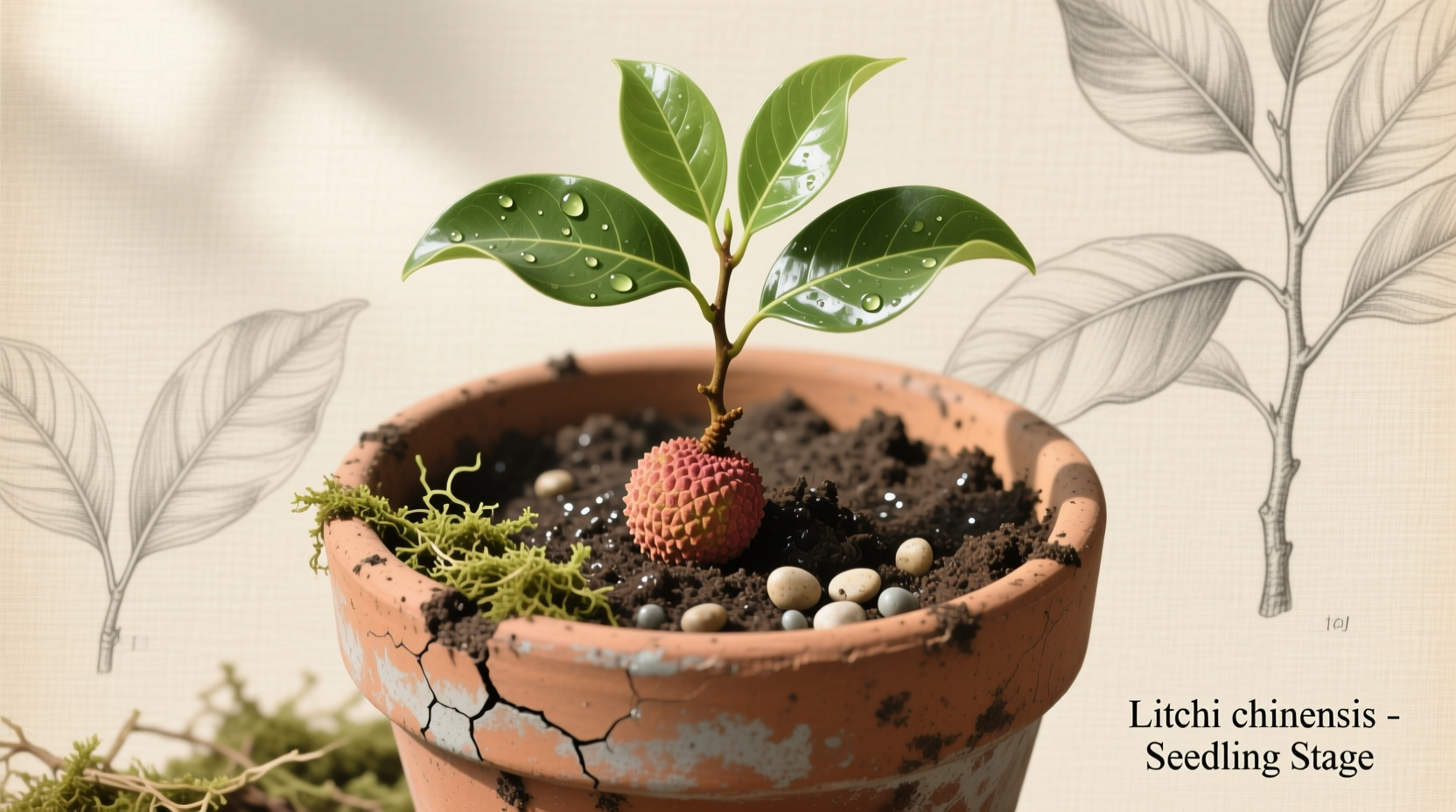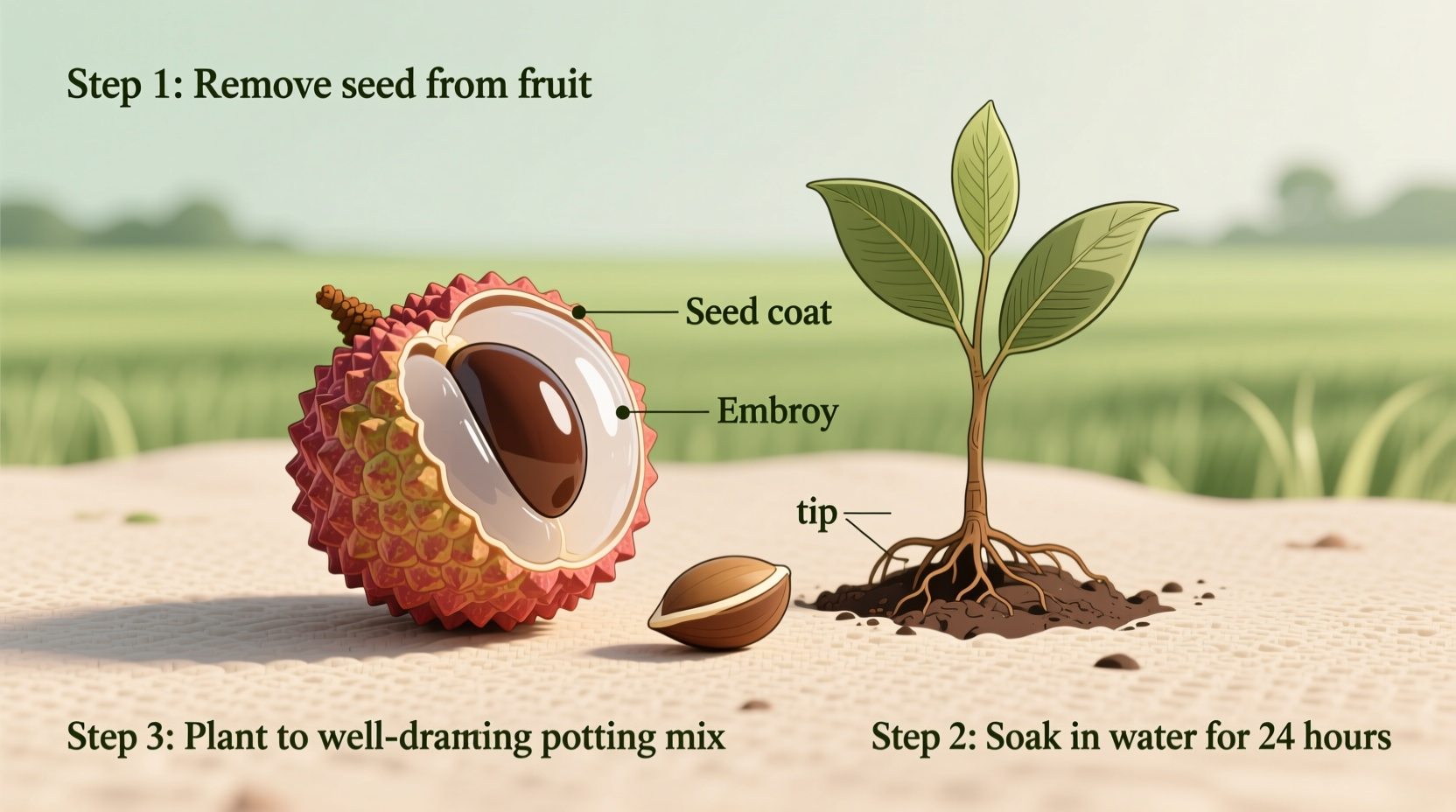Why Growing Lychee From Seed Is Worth the Effort
There's nothing quite like harvesting your own sweet, aromatic lychees from a tree you grew from a single seed. While commercial growers typically use grafting for consistent fruit quality, growing from seed offers a rewarding gardening journey that connects you to this ancient fruit's tropical heritage. I've helped hundreds of gardeners succeed with this method through my field research across Southeast Asia's lychee-growing regions.

Your Immediate First Steps (Don't Skip These!)
Timing is critical for lychee seed success. Unlike many fruits, lychee seeds lose viability rapidly after removal from the fruit. Follow these immediate actions:
- Extract and clean the seed within 24 hours of eating the fruit, removing all flesh residue
- Test viability by placing in water - viable seeds sink, floaters are usually dead
- Plant within 5 days maximum (freshness dramatically increases germination success)
- Never let seeds dry out - store wrapped in damp paper towel if delaying planting
| Seed Freshness | Germination Rate | Time to Sprout |
|---|---|---|
| Fresh (0-2 days) | 85-95% | 10-14 days |
| 3-5 days old | 60-75% | 2-3 weeks |
| 6+ days old | Under 20% | Rarely sprouts |
This data from University of Florida's Institute of Food and Agricultural Sciences demonstrates why immediate planting yields dramatically better results than waiting. Their research confirms that lychee seeds are recalcitrant, meaning they cannot withstand drying and quickly lose viability.
Perfecting Your Planting Setup
Creating the ideal environment for your lychee seed requires attention to three critical factors:
Soil Composition Matters Most
Lychees demand well-draining, slightly acidic soil. Create your mix with:
- 50% quality potting mix
- 30% perlite or coarse sand
- 20% compost or peat moss
Maintain pH between 5.0-5.5 - higher pH causes iron deficiency that stunts growth. Test your soil with an affordable pH meter; lychees growing in alkaline conditions develop yellow leaves within weeks.
Planting Depth and Orientation
Place the seed horizontally about 1 inch deep in the soil, with the slightly flattened side down. Unlike some seeds, lychee orientation affects root development. Cover lightly with soil and water thoroughly with room-temperature water.
Temperature Control Is Non-Negotiable
Lychee seeds require consistent warmth between 75-85°F (24-29°C) for germination. Below 70°F (21°C), germination slows dramatically or stops entirely. Consider these temperature solutions:
- Seedling heat mat set to 80°F
- Top of refrigerator (consistently warm)
- South-facing windowsill with supplemental grow light
Germination Timeline: What to Expect Week by Week
Understanding the growth stages prevents premature disappointment. Here's the typical progression:
| Timeframe | What's Happening Underground | Visible Signs | Care Requirements |
|---|---|---|---|
| Days 1-7 | Water absorption, metabolic activation | None visible | Maintain consistent moisture |
| Weeks 2-3 | Radicle (root) emergence | Slight soil movement | Keep warm (80°F ideal) |
| Weeks 3-4 | Shoot development | First green tip appears | Increase light exposure gradually |
| Month 2 | True leaves forming | 2-4 healthy leaves | Begin diluted fertilizer |
Patience is essential - some seeds take up to 4 weeks to show signs. The California Rare Fruit Growers Association notes that lychee seedlings develop slowly during their first year, focusing energy on root system development rather than visible growth.
Critical First-Year Care Practices
Many beginners lose seedlings during the transition from germination to established plant. Avoid these common pitfalls:
Watering Wisdom
Lychees need consistent moisture but hate soggy roots. Follow this watering rhythm:
- First month: Keep soil consistently moist (like a damp sponge)
- Months 2-6: Water when top inch of soil feels dry
- After 6 months: Water deeply when top 2 inches dry out
Use room-temperature, filtered water if your tap water is hard - lychees are sensitive to mineral buildup.
Light Requirements Evolution
As your seedling grows, its light needs change:
- First leaves: Bright, indirect light (east-facing window)
- 2-4 true leaves: Morning sun + afternoon shade
- 6+ months: 6+ hours of direct sunlight daily
Nutrition Strategy
Begin fertilizing at 2 months with these guidelines:
- Use balanced 10-10-10 fertilizer at ¼ strength
- Apply every 4 weeks during growing season
- Include chelated iron supplement monthly
- Stop fertilizing 8 weeks before first frost
Realistic Expectations: Seed vs. Grafted Trees
Understanding the limitations of seed-grown lychees prevents future disappointment. While growing from seed is rewarding, recognize these realities:
- Fruiting timeline: Seed trees take 10-15 years to bear fruit vs. 3-5 years for grafted trees
- Fruit quality: Only about 30% of seed-grown trees produce quality fruit comparable to the parent
- Tree size: Seed trees grow larger (30-40 feet) vs. grafted (15-25 feet)
The USDA Agricultural Research Service explains that lychees don't come true from seed due to genetic variability - your tree may produce fruit different from what you planted. Many gardeners grow seed trees as rootstock for later grafting with known varieties.
Troubleshooting Common Problems
When issues arise, diagnose quickly with this reference:
Yellowing Leaves
- New growth yellow, veins green: Iron deficiency (adjust pH lower)
- Entire leaf yellow: Overwatering or nitrogen deficiency
- Yellow leaf tips: Salt buildup from hard water or over-fertilizing
No Growth After 6 Weeks
- Check soil temperature - below 70°F halts development
- Verify seed freshness - older seeds rarely germinate
- Assess moisture levels - both too dry and too wet prevent growth
Dropping Leaves
- Sudden temperature changes
- Insufficient light
- Root-bound container
Your Long-Term Lychee Journey
Growing lychee from seed is a marathon, not a sprint. During years 2-5, focus on developing a strong root system and proper tree structure. Consider air-layering or grafting when your tree reaches ½ inch diameter to accelerate fruiting. Remember that lychees thrive in humid environments - if you live in a dry climate, mist regularly or use a humidity tray.
With proper care, your seed-grown lychee can become a beautiful, productive tree that connects you to centuries of tropical fruit tradition. The most successful growers treat the first 2-3 years as an investment period, focusing on establishing a healthy tree rather than expecting immediate fruit.











 浙公网安备
33010002000092号
浙公网安备
33010002000092号 浙B2-20120091-4
浙B2-20120091-4